Q & A with Artists from “Animalia”
The current group show at Sparks Gallery, “Animalia” features artwork from 32 artists. SG asked the exhibiting artists “Why do you choose to create work with animals as a theme? Do you have a cause that you are passionate about that involves animals?”
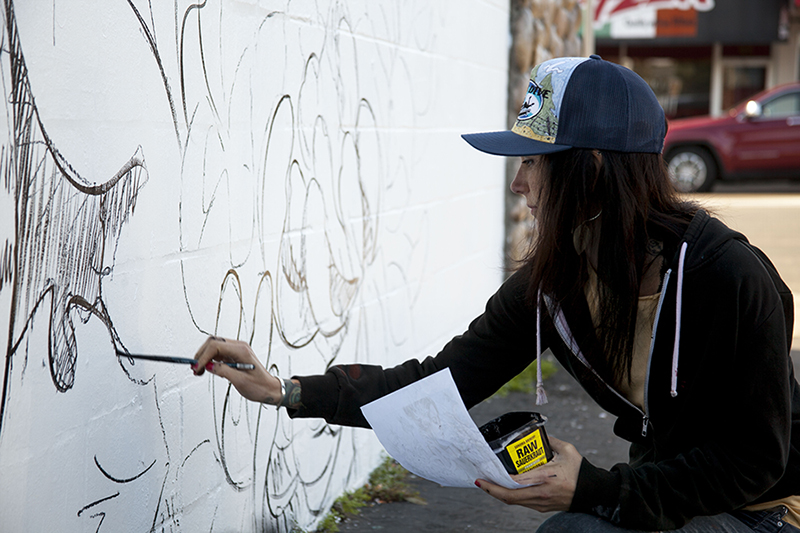
AmandaLynn at work
AmandaLynn: “I include creatures and nature in my works because I feel most at home and inspired when I am surrounded by both. I am very fortunate to have grown up in a family where taking nature walks is a top priority, most always accompanied by a few dogs and any furry friends we find along the way. I spent my younger years training and caring for horses on my Aunt’s ranch, and currently have a tortoise, lizard, snake, and puppy living in my apartment. I enjoy caring for animals, as I feel they ultimately are taking care of me.”
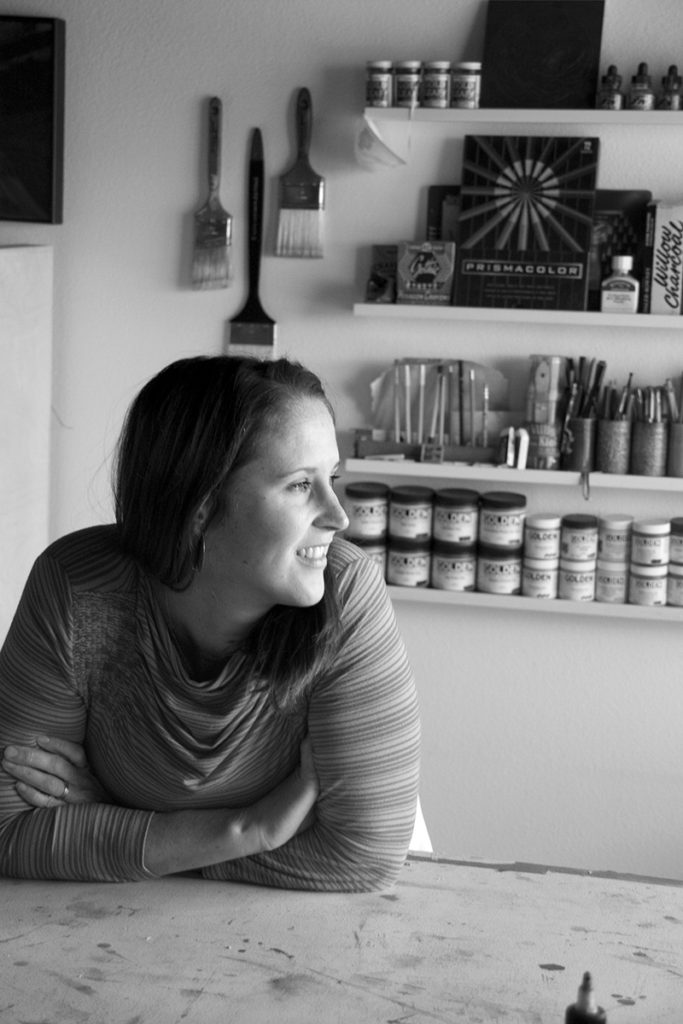
Amy Paul in studio
Amy Paul: “I first began working with animals as subject matter in my work when my grandmother passed away. I was heart broken by her loss and somewhere in the mourning process birds came to symbolize little guardians. I imagined they were couriers helping one to negotiate the transition from this world to the next. For the Animalia show, I wanted to channel my interest in animals as spiritual guides. I bought a set of spirit animal tarot cards when I was in high school and my interest in them has never wavered. The Totem series is the start of that exploration. It’s an exercise in portraiture that represents both my loved ones and their correlating spirit animal guide.”
Anna Van Fleet: “I love the idea of animals as a theme! I find it very supportive for our nature and environment. I enjoy being part of it. I think people should care more about nature. It is my hope that my work can help inspire a shift in consciousness, that leads to a more eco-friendly culture.”
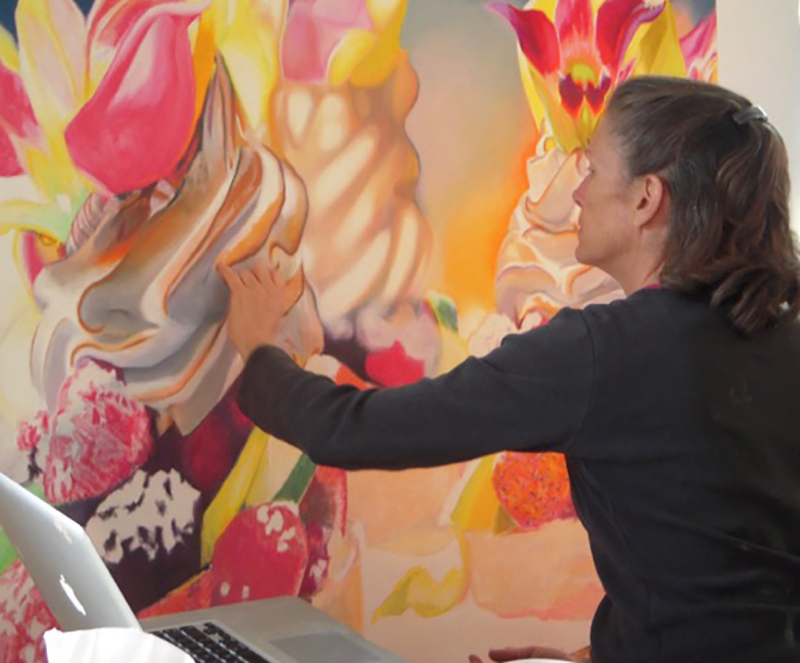
Barbara Ann Stanley working on a commissioned work for Heaven Sent Desserts.
Barbara Ann Stanley: “Ever since the beginning of humans, animals have been used as universal symbols representing knowledge and direction in dreams and life. Also animals are the mirror to our world. They show us how well we, as human and stewards of this planet, are doing. I read recently that there was a massive die off of over 10,000 endangered frogs and other water-dwelling animals living near Lake Titicaca in South America because of human sewage and pollution. Humans don’t realize that even something as small as bees dying off en masse can have a major impact on our food chain.
I choose to create works with animals as a theme because they are ever present in my life. I have always had a dog and cat in my life. At a very young age I came to realize that all animals are sentient beings and have a deep internal life. Because of this I have not eaten animals for over thirty-five years.
As sentient beings ourselves we can choose to support humanely raised and killed animals that serve and feed us. We can support companies that do not test on animals. We have the knowledge now to not use animals in many areas of science research. We can support our government officials that pass laws that protect animals. A major win for animals last year was when President Obama signed into law the Frank R. Lautenberg Chemical Safety for the 21 Century Act which updates the Toxic Substances Control Act of 1976, which replaces and reduce animal-based tests with modern methods to assess the toxicity of chemicals. Groups like Physicians Committee for Responsible Medicine (pcrm.org) work diligently towards goals informing universities and science institutions about different options other than using animals for testing.
Luckily we can make a difference by eating less animal products and buying free range when possible. Buy products from companies that don’t test on animals. Don’t use harsh chemicals around your home and yard. Buy more organic products. Recycle. Encourage the science community and our government to get away from the use of live animals for research. Vote for people who support the EPA. Never quit trying to make little changes to better the lives of animals and our planet. Do what’s in front of you, change what you can little by little. Be kind, be loving, have joy, and keep trying to be the person your dog thinks you are.”
Brennan Hubbell: “I work with animals because their hearts seem to be in the right place. People, on the other hand, it often seems a struggle to even find one’s heart.
I want to increase the wilderness in the world. Wilderness is where animals can be beastly and not even observed by human beings. I feel that cultivating wilderness in the outer world must also be a cultivation of wilderness in ourselves. There is a vast need in our world for unknowing: for discarding the filters of our thoughts, for culture to be wild. Our emotional baggage can be unlearned from animals. Wilderness is vital.”
Carmem Gusmao: “I love animals! I was born in Minas Gerais, Brazil, but I grew up in Amazonia. My father was a farmer and I spent all my weekends, as a teenage girl, on the farm. Riding horses, taking care of little animals. Later on when I was already an artist, I used to live inside the jungle with the Kayapo Indians and I was hypnotized by the little birds’ music! My father told me some enchanted histories about birds and I decided to immortalize them in my paintings. I paint birds from my memory, I never use a model or photo to do it!!! Birds represent freedom and courage to change when the life’s weather is not good anymore!!”
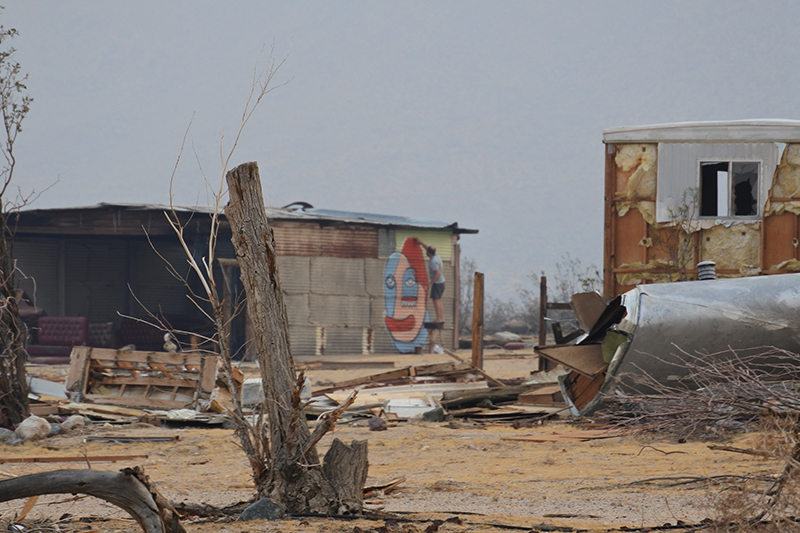
Eric Wixon at work
Eric Wixon: “My earliest artistic memory is from around the age of 5. I distinctly remember forming mental images out of the formica paneling in front of the bathtub. The process was similar to how people see imagery in cloud formations. The major difference is that the formica is a constant whereas clouds vary. Every day while bathing I would try to visualize the same images I saw the day before as well as come up with new imagery. The majority of mental imagery I came up with was either faces, animals, or some combination of the two. To this day I employ a similar practice by scribbling in an autonomous manner or using various methods of chance as a starting point for my work. A sketch, which often combines faces and animals, is derived from the previous marks and used as a basis for the painting. In addition to animal imagery naturally occurring in my visual lexicon I’m convinced animals instinctively know a caring person.”
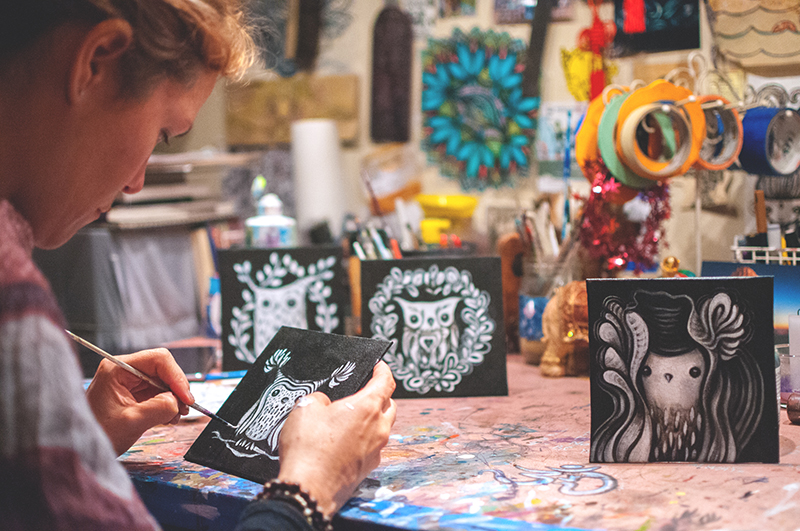
Gloria Muriel working on “Owlito” series
Gloria Muriel: “I love animals. They are therapeutic for me. Always in the present moment. Aware of their surroundings and connected with Mother Earth. They’re wise without being thinkers. I’m fascinated by their natural instincts and how they communicate with each other. Amazing creatures.”
Gregory Bada: “I incorporate animals in my work to explore the connection we share with them. In many ways an animal can display the rawest and most honest of instincts and emotions.
In my fantasy, dreamlike creative work, I often wonder what it would be like to live in harmony with all the creature of the earth and blend that connection into much of my work.
I am an active contributor to the Humane Society of San Diego and often take my son with me to volunteer however we can. In fact at last year’s Mission Federal ArtWalk NTC my four-year-old son showed a few of his works along side mine and made it clear that if any of them sold he wanted to give the money to ‘dogs and cats that don’t have homes.’ It was awesome.”
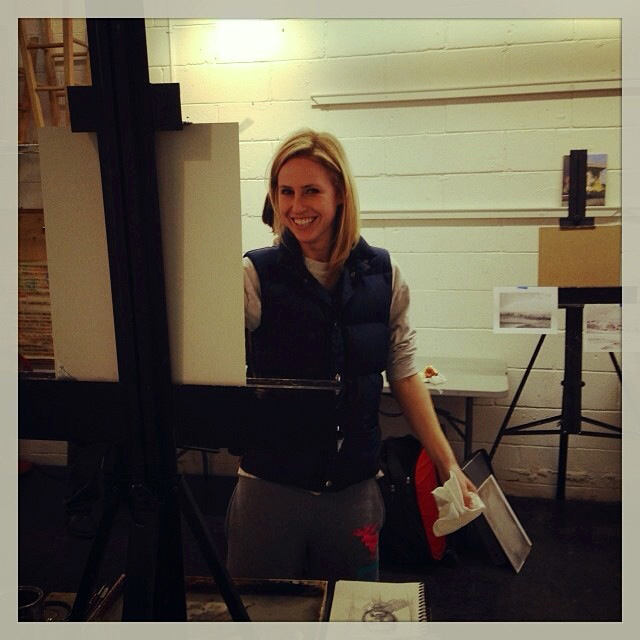
Heather Lenefsky at work
Heather Lenefsky: “I think it was actually my love for animals that led me to discover my love for art. I remember the first time I drew from observation. I was in maybe 1st or 2nd grade and my best friend, a gigantic black cat named Figaro, was asleep at the top of the stairs. It astonished me when I realized the shapes weren’t just in a symbolic profile, or dead straight on like the icons we initially learn to draw. I had never heard of perspective, but my curiosity and my cat were my first bread crumb in the right direction, and now animals are by far my most popular commission request. I still have that little marker drawing, complete with heavy doses of Whiteout.
I am very passionate about animals. In another life if I didn’t live in a small studio apartment barely big enough for me, my easel, and my two big cats, I would probably have a ‘Dalmatian Plantation’ a la Disney with all manner of creatures. For now, I donate to shelters and rescue organizations, and throw down a few extra bucks to support things like Vital Farms Pasture Raised eggs with the happy looking chickens. I still can’t listen to the Sarah McLachlan song from the ASPCA commercial without tearing up!”
Optimus Volts: “I like to work with animal themes to create a challenge in my artwork. I use recycled material to create wall sculptures but it becomes a challenge to make it look like an animal. In some of my work, I like to bring back the animal’s honor by creating a new skin.”
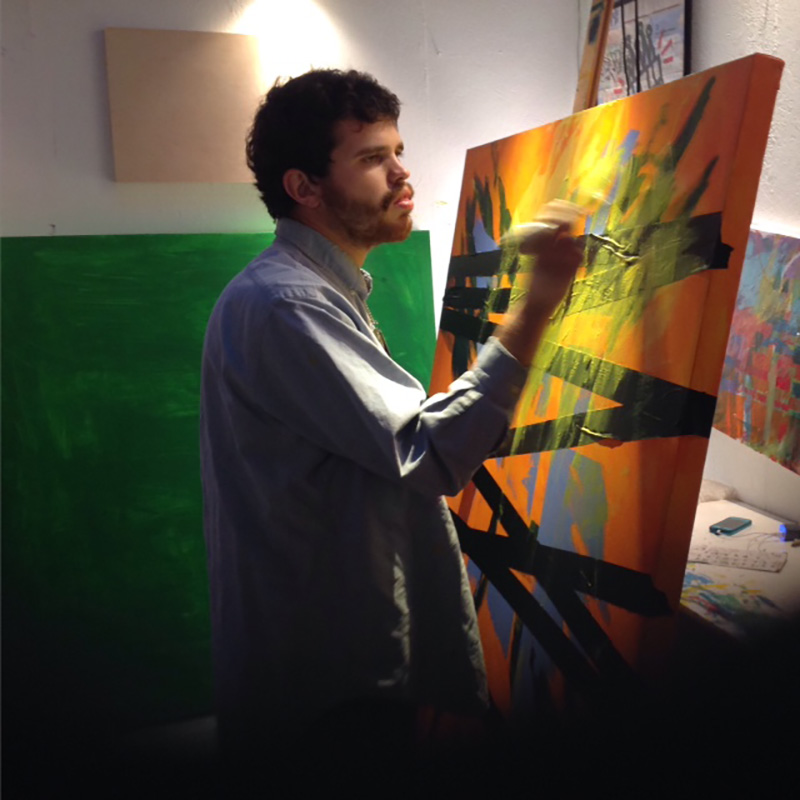
Jeremy Sicile-Kira painting in studio
Jeremy Sicile-Kira: “Very much kindly I love all animals. Greatly, Handsome my dog is very dear to me. Very much all animals have a purpose. Very much I’m passionate about all animals, as they can be very therapeutic to people. When I see animals at the Wild Animal Park, I feel connected to them because I can feel their emotions and see their auras. Frankly, I also like to visit the ‘Butterfly Jungle’ there every Spring. Truly, I have a deeper connection with butterflies because butterflies come back to visit those who need up-lifting. The butterflies bring happiness.”
Jo Palasi: “I like that animals are unpredictable. They are a challenge to photograph from the smallest hoverfly to a herd of grazing buffalo. Animals can be an exercise in patience sprinkled with a bit of luck. I wait for that moment when they turn their head a certain way, so I can capture them in their element. For me, animals are much easier to work with than people. I’ve never had an animal ask me to delete a photograph because they did not like it.”
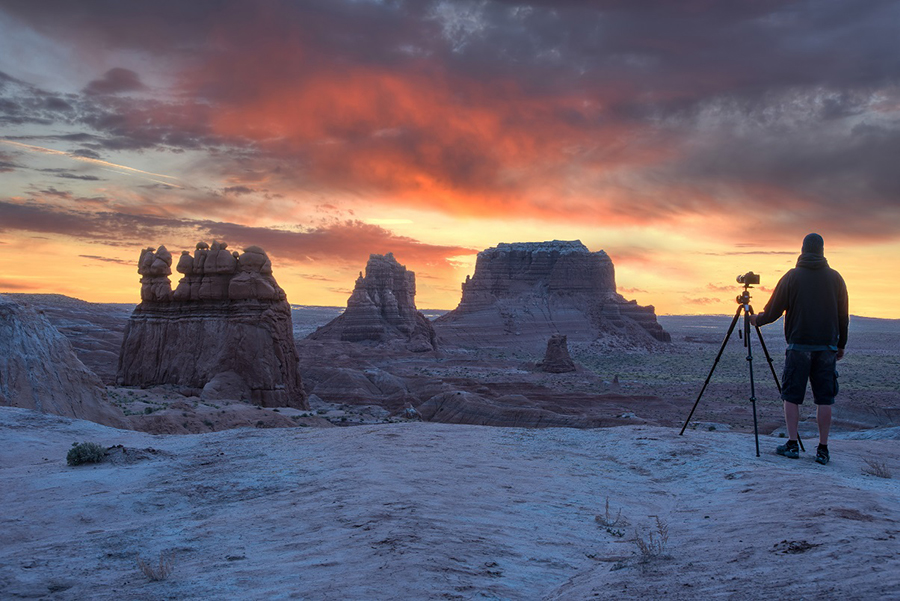
Jon Barnes at work in his ‘studio’
Jon Barnes: “For me, my love of wildlife and nature is what creates the passion I have for photography. If there is one thing that can totally make my day when I am shooting a beautiful landscape it is when I am joined by one of our furry friends. I’ve seen bears, bison, moose, bighorn sheep (commonly referred to as ‘rams’), elk, whales and dolphins, just to name a few.
Every experience I have ever had with any of them has been very dear to my heart and something I appreciate and will never forget.
Whether it is watching whales, dolphins and the many bird species that call the sea home or watching bison graze in the open fields of Wyoming, I can never get enough of the animals we share this beautiful world with.”
Judy Salinsky: “I love the ocean. Surfing, SCUBA diving, bodysurfing; the ocean has been an important part of my life for as long as I can remember. While on night dives at La Jolla Shores, I witnessed hundreds of dancing bat rays enjoying the delicacies of the squid spawning. Gently gliding along the ocean bottom, the moonlight’s glow casting their wings as a larger than life shadow on the sand below us.
A sight I will never forget.
Another unforgettable memory is of their cousins, the stingray. Hiding quietly in the shallows of our sandy shoreline, until someone forgets to do the ‘stingray shuffle’ and gets nailed by their barbed tails. I have had the unfortunate privilege to be struck three times by the incredible pain that comes with disturbing these beautiful creatures. My painful experiences motivated me to cast the desk-sized bronze sculpture ‘Ocean Dancer‘.
After receiving first place at the San Diego Fair for my ‘Ocean Dancer’ sculpture, I realized there is a place for a larger bronze art instillation designed to educate the beach-going public on the animals’ presence and our need to coexist with this creature in nature. ‘Ocean Dancer’ has been on display at the Encinitas Off Track Gallery, Encinitas Plein Air competition, San Clemente Artist Gallery, and she can be viewed at the Del Mar Art Center. ‘Ocean Dancer’ is the beginning of many ocean creatures that I am planning to create.”
Kelly Paige Standard: “I create works with animals in them because I have always been an animal lover. I’m the girl at the party that goes to find the resident fur-kids, and can be found in a quiet room where they are.
Animals really are here to help us be better. And, when tragedy strikes, they’ve got out backs without question and without reservation. That kind of love deserves to be celebrated. Since I know loss in a pretty intimate way, I’m a fan of the posthumous portrait; humans AND animals. Whatever makes your heart sing, you should have around you in your space.
I donate work to Chihuahua Rescue of San Diego, and have helped on a Xolo rescue run, and a pit bull adoption run for Compassionate Animal Rescue for Medical Aid (CARMA).”
Lee Sie: “I have found Koi fish intriguing since the day I was introduced to water gardening and backyard ponds. I have always been struck by their elegance and fluidity. When I watch them, I feel serene and calm. I try to capture my observations and feelings when I photograph them, seeing the patterns of their movement as one hears the rhythms of a song. I take my Koi fish photographs to the next level by using vibrant color processing to add an extra visual stimulus for my viewers.”
Lenore Simon: “The beauty and uniqueness of so many of nature’s wonderful creatures are a challenge from the usual study of our own species. Being less accessible than humans, they represent a greater challenge as subject matter when one is fortunate to have them within one’s field of vision.”
Li Huai: “The first time I saw a Panda was at the Beijing Zoo in China when I was little. They looked fluffy and cuddly. Years later, they are still looking fluffy and cuddly. Furthermore, they are precious, exotic, and international. As an artist, I create images of pandas. The pandas function as a perfect medium for intellectual expression on the part of the artist and multiple interpretations on the part of viewers.
As an artist, my involvement with animals is constant and fluid as expressed in my creation. In many ways, they are a mirror of us.”
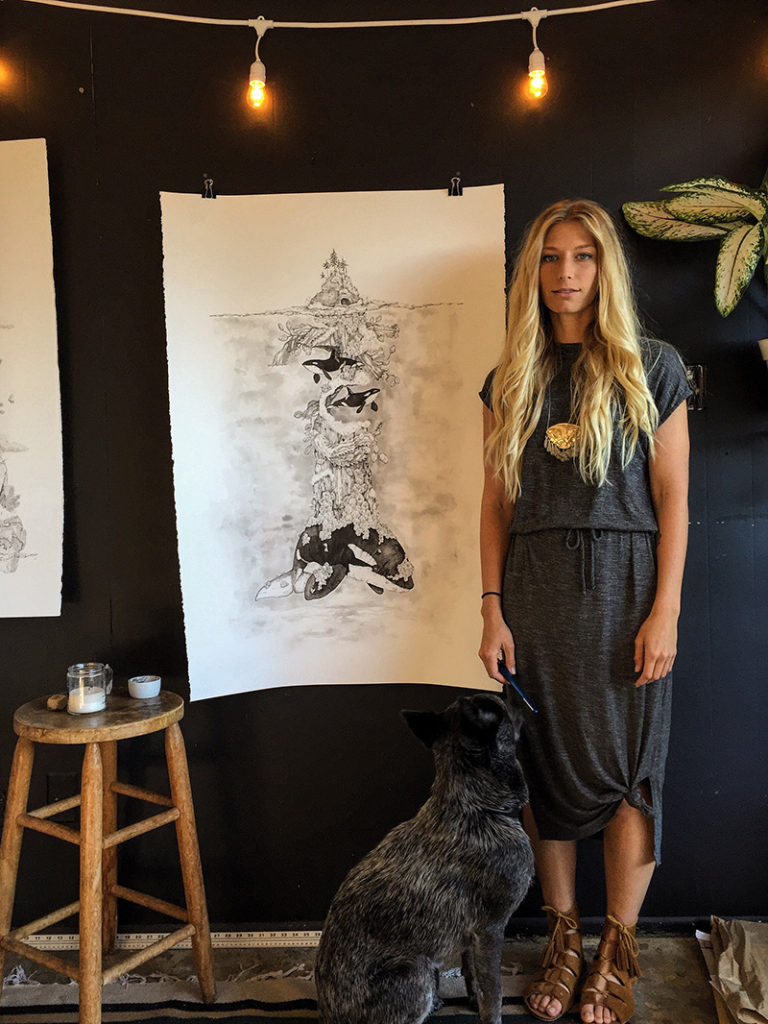
Marissa Quinn in the studio with Diluvium
Marissa Quinn: “I choose to create work with animals for two purposes – to raise awareness on threatened and endangered species while tapping into a universal spiritual narrative to reveal spiritual teachings to an audience. My work has an undercurrent of indigenous mythology through which I am able to tap into an emotional and spiritual realm of story telling in order to inspire conservation action.
For the past 7 years I have been creating work on honeybee conservation while learning the art of beekeeping. I am also currently working on several pieces about whale conservation and oceanic restoration. Most recently I have been asked to create drawings on the Standing Rock conflict and the Lelu Island controversy in Washington (www.laxuula.com).”
Monica Hui Hekman: “The inspiration for most of my work comes from nature. I enjoy exploring and learning about plants and animals, whose characteristics and behaviors enable them to thrive in their environment.
Although not professionally trained, I consider myself a junior scientist of sorts! I believe it’s important to feed the sense of wonder that comes from learning and discovering new things. Maybe then we can learn how to respect our planet and the sentient beings we share it with.”
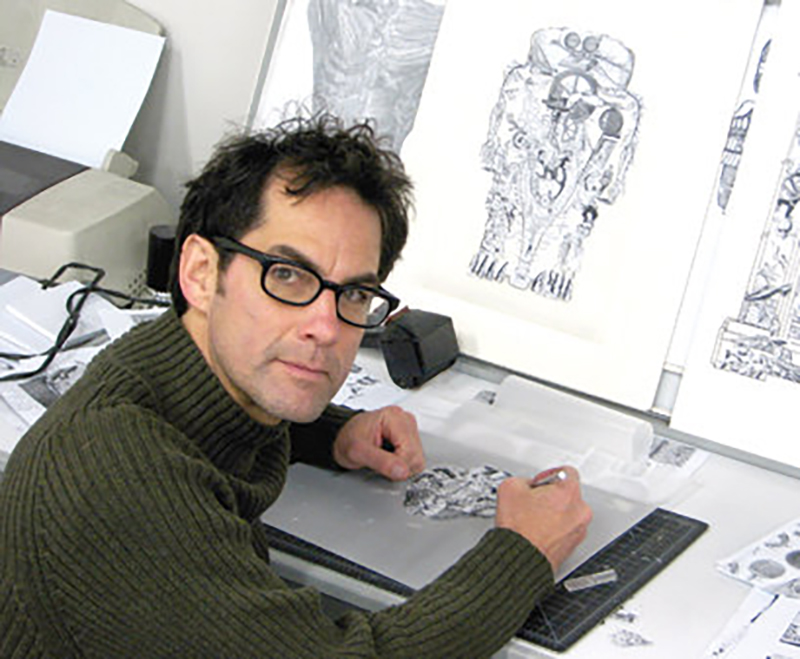
Perry Vasquez at work
Perry Vasquez: “I am inspired by the natural landscapes but I can’t say that I have a special love for animals. I respect them and wish them well.”
Robby Ticknor: “Love the diversity of the animal kingdom, from a soaring bird to a dark scary spider. There is so much variety, and so much beauty in nature. I try to capture the majesty and emotion of my animal subject in a way that brings them to life and tells a story.”
Victoria Hanlon: “I find that the natural world (including animals) to be an unlimited source of study and grounding for daily life.”

